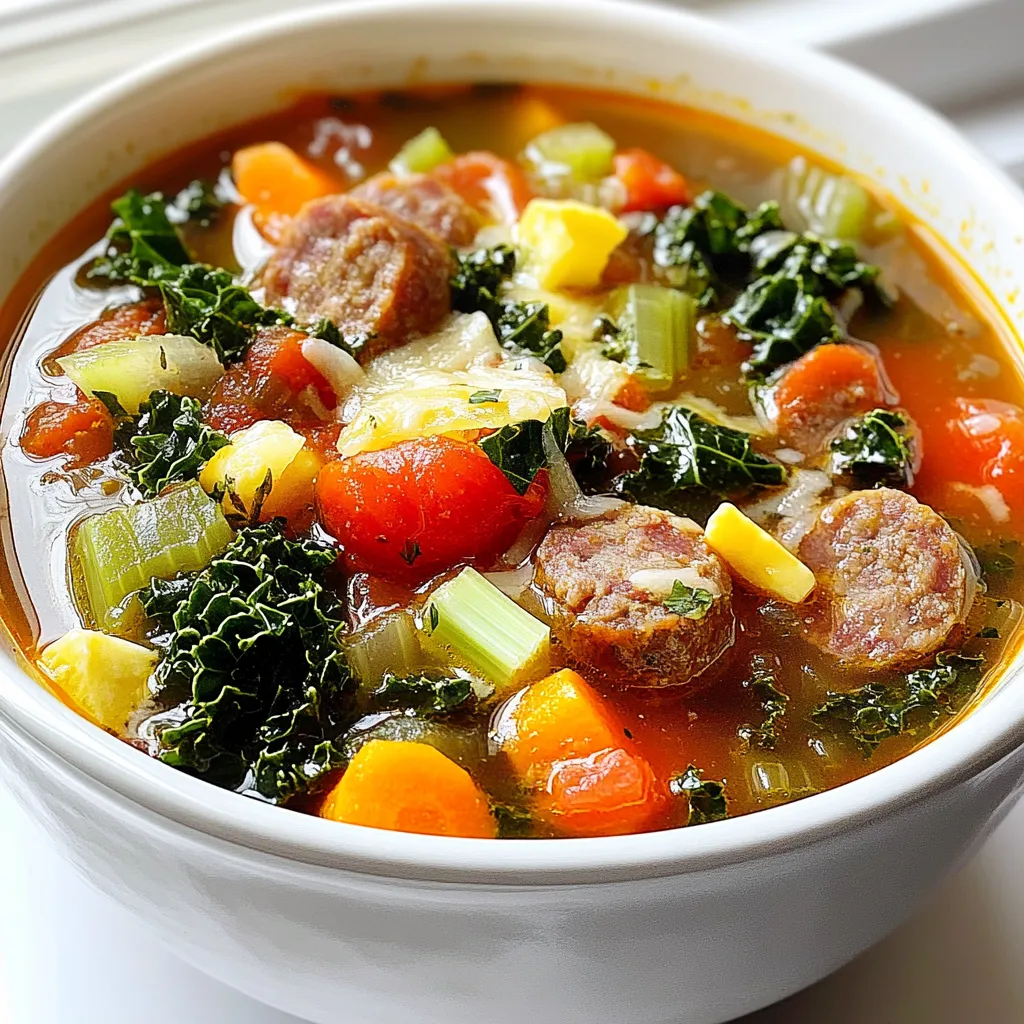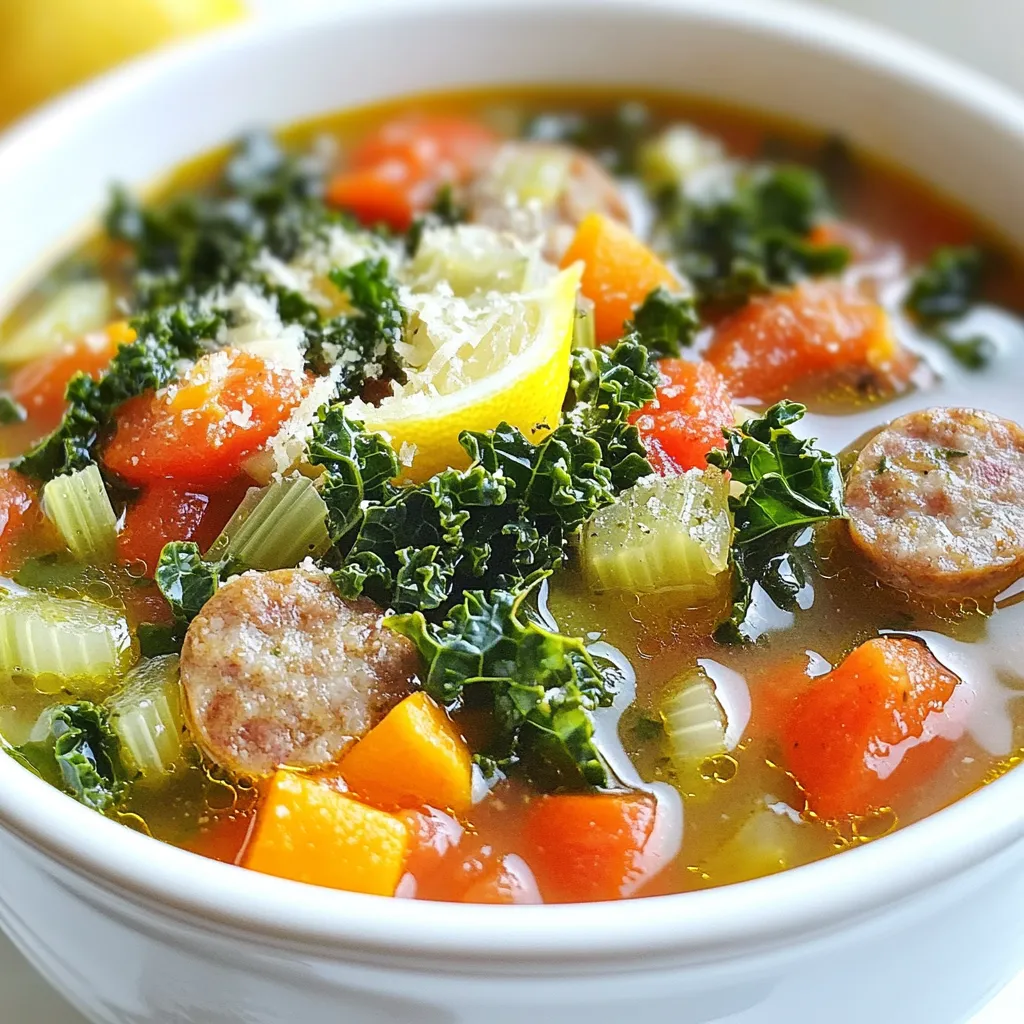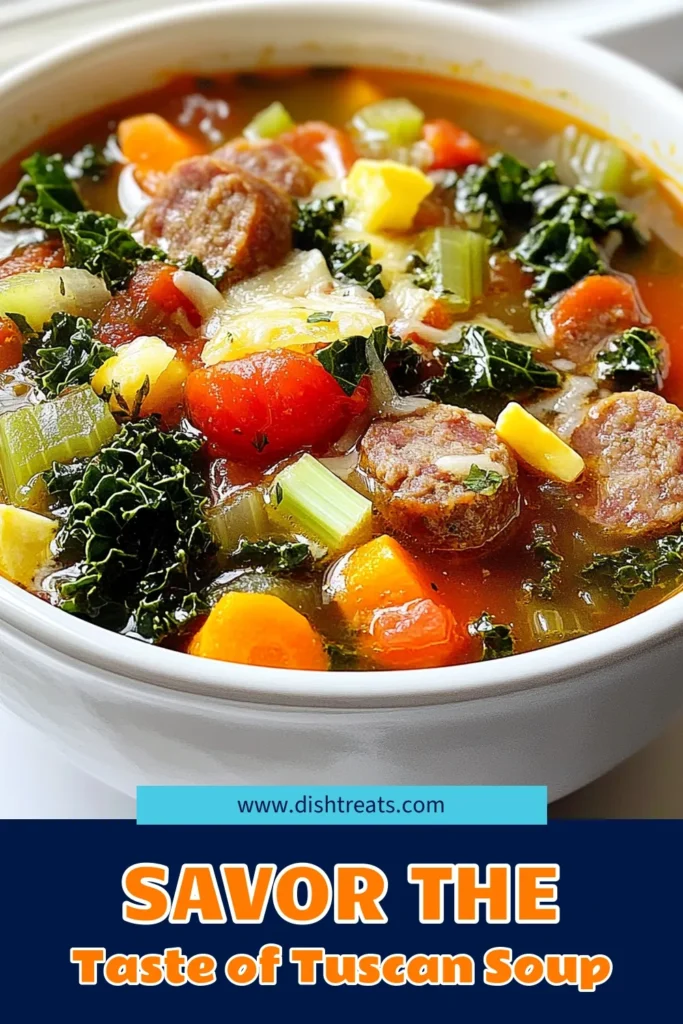Tuscan Sausage Soup Hearty and Flavorful Classic

Looking for a warm and hearty dish that packs a punch? This Tuscan Sausage Soup is just what you need. With rich flavors and simple ingredients, it’s perfect for any weeknight. I’ll guide you through every step, from selecting the best sausage to storing leftovers. Get ready to impress your family and friends with a classic dish that warms the soul!
Ingredients
Essential Ingredients for Tuscan Sausage Soup
To make a great Tuscan sausage soup, you need some key items:
- 1 pound Italian sausage (mild or spicy)
- 1 medium onion, finely diced
- 2 cloves garlic, minced
- 3 medium carrots, peeled and sliced
- 2 celery stalks, diced
- 4 cups vegetable broth
- 1 can (14 oz) diced tomatoes with Italian herbs
- 1 can (15 oz) cannellini beans, drained
- 2 cups kale or spinach, roughly chopped
- 1 teaspoon dried oregano
- 1 teaspoon dried basil
- Salt and pepper to taste
- 2 tablespoons olive oil
- Juice of 1 lemon
- Grated Parmesan cheese for serving (optional)
These ingredients create a warm, hearty soup that fills you up and excites your taste buds.
Optional Ingredients for Enhanced Flavor
You can add a few extra items to boost the taste:
- Red pepper flakes for heat
- Fresh herbs like parsley or thyme
- Extra veggies such as zucchini or bell peppers
- A splash of white wine for depth
These optional ingredients can make your soup even more special.
Nutritional Information Breakdown
This soup is not just tasty; it is also healthy. Here’s what you get in one serving:
- Calories: Approximately 320
- Protein: 17g
- Fat: 12g
- Carbohydrates: 40g
- Fiber: 10g
The soup offers a good mix of nutrients, making it a great choice for any meal. You’ll enjoy the flavors while knowing you’re eating well.
Step-by-Step Instructions
Preparation Steps for Perfect Soup
Start by gathering all your ingredients. This makes cooking easier. You need:
- 1 pound Italian sausage
- 1 medium onion, finely diced
- 2 cloves garlic, minced
- 3 medium carrots, peeled and sliced
- 2 celery stalks, diced
- 4 cups vegetable broth
- 1 can diced tomatoes with Italian herbs
- 1 can cannellini beans, drained
- 2 cups kale or spinach, roughly chopped
- 1 teaspoon dried oregano
- 1 teaspoon dried basil
- Salt and pepper to taste
- 2 tablespoons olive oil
- Juice of 1 lemon
- Grated Parmesan cheese (optional)
Next, prepare your veggies. Dice the onion, slice the carrots, and chop the kale or spinach. These steps help the soup cook evenly.
Cooking Process Explained in Detail
In a large pot, heat olive oil over medium heat. Once hot, add the Italian sausage. Use a wooden spoon to break it apart. Cook until it’s browned, about 6-8 minutes. Remove the sausage and set it aside.
In the same pot, add the diced onion, sliced carrots, and diced celery. Cook for about 5 minutes. Stir often until the onion is soft and clear. Then, add the minced garlic. Cook for 1 more minute. The garlic should smell nice but not burn.
Now, stir in the diced tomatoes with their juices and the vegetable broth. Add back the sausage. Turn the heat up a bit and bring it to a gentle simmer.
Once it starts simmering, add the cannellini beans, dried oregano, dried basil, salt, and pepper. Let it simmer for about 15 minutes. This helps all the flavors mix well.
After 15 minutes, fold in the chopped kale or spinach. Cook for another 5 minutes until the greens are tender and bright.
Final Touches Before Serving
Just before serving, squeeze in the lemon juice. This gives a fresh taste. Taste the soup and adjust the salt and pepper if needed.
Serve the soup hot. You can offer grated Parmesan cheese on the side. Enjoy your hearty and flavorful Tuscan sausage soup!
Tips & Tricks
Best Practices for Flavor Enhancement
To make your Tuscan sausage soup shine, focus on fresh ingredients. Use ripe tomatoes for a rich taste. Fresh garlic adds depth, so opt for it over powder. When cooking the sausage, let it brown well. This creates a nice base flavor. Adding lemon juice at the end brightens the dish. It balances the richness of the sausage. Lastly, a sprinkle of grated Parmesan brings everything together.
Common Mistakes to Avoid
One common mistake is overcooking the vegetables. They should be tender but not mushy. Another mistake is not seasoning enough. Taste your soup as it cooks and adjust with salt and pepper. If you skip the lemon juice, you miss a key flavor twist. Don’t forget to add the greens at the right time. They need just a few minutes to wilt and maintain their color.
Serving Suggestions and Pairings
This soup pairs well with crusty bread. A slice of sourdough or ciabatta works best. You can also serve a simple side salad. A mix of greens with a light vinaigrette complements the soup flavors. For a cozy touch, consider a glass of red wine. A Chianti or Sangiovese enhances the Tuscan theme. Enjoy your meal with family or friends for a warm gathering.

Variations
Vegetarian or Vegan Options
You can easily make a vegetarian or vegan version of this soup. Swap the Italian sausage for plant-based sausage or mushrooms. Use vegetable broth to keep it flavorful. For protein, add extra cannellini beans or lentils. This gives the soup a hearty feel without meat.
Ingredient Swaps and Additions
Feel free to get creative with your ingredients. If you don’t have kale, spinach works just as well. You can also add zucchini or bell peppers for extra flavor. Swap out the cannellini beans for chickpeas if you prefer. For a spicier kick, try adding red pepper flakes.
Seasonal Variations for Tuscan Sausage Soup
You can adjust this soup to fit the seasons. In fall, add diced butternut squash for sweetness. In winter, toss in some sweet potatoes for a warm touch. Spring offers fresh peas or asparagus, which brighten the dish. Summer is perfect for using garden-fresh tomatoes and basil to enhance flavors.
Storage Info
How to Properly Store Leftover Soup
After enjoying your Tuscan sausage soup, let it cool down. Transfer it to an airtight container. This keeps the soup fresh. Store it in the fridge for up to three days. If you want to keep it longer, consider freezing.
Reheating Instructions for Optimal Taste
When you’re ready to enjoy your soup again, heat it gently. Pour the soup into a pot over medium heat. Stir it often to prevent sticking. Heat until it’s hot throughout. You can add a little broth or water if it seems thick. This helps bring back its creamy texture.
Freezing Tips for Long-Term Storage
To freeze your soup, make sure it’s cool. Use freezer-safe containers or bags. Leave some space at the top for expansion. Label each container with the date. You can freeze the soup for up to three months. When you’re ready to eat, thaw it in the fridge overnight. Reheat as mentioned above for the best flavor.
FAQs
What spices can I add to Tuscan Sausage Soup?
You can add many spices to enhance the flavor of your soup. Try using red pepper flakes for heat. A pinch of thyme adds earthiness. You might also like smoked paprika for a deeper taste. Fresh herbs like parsley or chives add a bright touch too. Experiment with spices to find your favorite mix.
Can I use different types of sausage?
Yes, you can use different types of sausage. Mild Italian sausage works well, but spicy sausage adds a kick. You might try chicken sausage for a lighter option. Even turkey sausage can be a great choice. Each type brings its unique flavor, so feel free to mix it up.
How can I make this soup gluten-free?
To make Tuscan Sausage Soup gluten-free, choose gluten-free broth. Check the sausage for gluten, as some brands add fillers. Instead of traditional bread for serving, use gluten-free bread if you like. This way, everyone can enjoy this tasty soup without worry.
This blog covered how to make Tuscan sausage soup. We explored key ingredients and added options for extra flavor. I shared step-by-step cooking instructions, tips to enhance taste, and common mistakes to avoid. You also learned about different variations and how to store leftovers well.
In the end, making this soup is easy and fun. With a few simple steps, you can create a tasty meal for any occasion. Enjoy your cooking!





![- 4 bone-in chicken thighs, skin-on - 2 medium zucchinis, sliced into half-moons - 1 bell pepper (red or yellow), chopped into bite-sized pieces - 1 cup cherry tomatoes, halved - 1 red onion, cut into wedges - 4 cloves garlic, minced - 1/4 cup extra virgin olive oil - Juice of 2 fresh lemons - Zest of 1 lemon - 2 teaspoons dried oregano - 1 teaspoon smoked paprika - Sea salt and freshly cracked black pepper to taste - Fresh parsley, finely chopped for garnish Using fresh ingredients makes this dish taste great and healthy. Chicken thighs have good flavor and keep moist while cooking. Zucchini and bell peppers add vitamins and minerals. Cherry tomatoes offer a sweet burst with every bite. Garlic adds depth and may boost your immune system. Olive oil is a healthy fat that helps with heart health. Fresh lemon juice brightens the dish and adds vitamin C. Oregano and paprika bring warmth and nice aroma to the meal. You can swap chicken thighs for chicken breasts if you prefer leaner meat. Use any bell pepper color you like. If you have other veggies on hand, such as carrots or green beans, feel free to add them. For a different flavor, try using lime juice instead of lemon juice. If you don't have fresh garlic, garlic powder works too. You can replace olive oil with avocado oil for a similar taste. Start by making the marinade. In a medium bowl, mix together the olive oil, lemon juice, lemon zest, minced garlic, dried oregano, smoked paprika, sea salt, and black pepper. Whisk this mix until it’s smooth and bright. Next, take your chicken thighs. Place them in a large resealable bag or a shallow dish. Pour half the marinade over the chicken. Make sure each piece gets coated well. Seal the bag or cover the dish. Let it sit in the fridge for at least 30 minutes, or up to 2 hours for extra flavor. While the chicken marinates, preheat your oven to 425°F (220°C). This step is key for perfect roasting. Now, prepare your veggies. In a large bowl, toss together the sliced zucchini, chopped bell pepper, halved cherry tomatoes, and onion wedges. Drizzle the remaining marinade over the veggies. Toss them gently to coat evenly. Once prepped, line a sheet pan with parchment paper. This helps with easy cleanup. Place the marinated chicken in the center of the pan. Surround it with the veggies, spreading them out nicely. Put the sheet pan in the oven. Bake for 30 to 35 minutes. The chicken should reach an internal temperature of 165°F (75°C). The veggies should become tender and slightly caramelized. To check if the chicken is done, use a meat thermometer. Insert it into the thickest part of the thigh. If it reads 165°F (75°C), it’s ready. If not, bake a bit longer, checking every few minutes. Once done, take the pan out of the oven. Let it rest for a few minutes. This helps keep the juices in the chicken. Finish with a sprinkle of fresh parsley for color before serving. Enjoy your meal! To get the most flavor, marinate the chicken thighs. Use a mix of lemon juice, zest, garlic, and spices. This mix creates a tasty coating that seeps into the meat. I recommend marinating for at least 30 minutes. For deeper flavor, marinate for up to 2 hours. Always keep the chicken in the fridge while it soaks. This keeps it fresh and safe to eat. Seasoning is key to making your dish pop. Use sea salt and freshly cracked black pepper. They enhance the chicken and veggies. You can also try smoked paprika for warmth and depth. Dried oregano adds a nice herb flavor. Make sure to sprinkle seasonings evenly over everything. Taste as you go to ensure the flavors are just right. Cleanup can be a breeze with parchment paper. Line your sheet pan with it before adding the chicken and veggies. It prevents sticking and makes for easy cleanup. Once the meal is done, just toss the paper away. You can spend more time enjoying your meal, not scrubbing dishes. This little trick saves time and effort in the kitchen. {{image_4}} You can swap chicken thighs for other proteins. Try bone-in chicken breasts or turkey thighs. They will give you a similar juicy flavor and texture. If you want something lighter, go for shrimp or firm tofu. Shrimp cooks fast and adds a sweet touch. Tofu soaks up the lemon flavor well. Make sure to adjust your cooking time based on what protein you choose. Using seasonal veggies makes your dish fresh and vibrant. In the summer, use squash, corn, or eggplant. For fall, add sweet potatoes or Brussels sprouts. Winter calls for hearty greens like kale or root vegetables. You can mix different colors and textures for a fun look. Don’t be afraid to get creative and use what you love! Herbs and spices can really change your dish. For a fresh taste, add thyme or rosemary. If you want a kick, sprinkle in some red pepper flakes. For a bit of sweetness, try adding a dash of cinnamon. Feel free to mix and match spices. Experimenting can lead to unique flavors that you’ll want to make again! For the full recipe, check out the Zesty Sheet Pan Lemon Chicken & Veggie Medley. To store leftovers, let the chicken and veggies cool first. Transfer them to an airtight container. This keeps them fresh and prevents odors. You can store them in the fridge for up to three days. If you want to keep them longer, freezing is a great option. When you’re ready to eat, reheating is simple. Preheat your oven to 350°F (175°C). Spread the chicken and veggies on a baking sheet. Heat for about 15 to 20 minutes, or until warmed through. You can also use a microwave. Place the food in a microwave-safe dish, cover loosely, and heat in short bursts. Stir in between to ensure even heating. If you plan to freeze your leftovers, do it as soon as they cool. Place portions in freezer bags or containers. Remove as much air as possible to avoid freezer burn. This dish can last for up to three months in the freezer. When you’re ready to eat, thaw it overnight in the fridge before reheating. This method keeps the flavors intact and makes for a quick meal. For more delicious ideas, check out the [Full Recipe]. To make sheet pan lemon chicken and veggies, start by prepping the marinade. Mix olive oil, lemon juice, lemon zest, garlic, oregano, smoked paprika, salt, and pepper in a bowl. This creates a zesty mix. Next, marinate the chicken thighs in half of this mixture for at least 30 minutes. While the chicken marinates, preheat your oven to 425°F (220°C). Prepare your veggies by mixing zucchini, bell pepper, cherry tomatoes, and red onion in another bowl. Toss them with the leftover marinade. Line a sheet pan with parchment paper for easy cleanup. Place the marinated chicken in the center and surround it with the vegetables. Bake for 30-35 minutes at 425°F until the chicken reaches 165°F (75°C). Let it rest before serving. For the full recipe, check out the complete guide. Yes, you can use boneless chicken for this recipe. Boneless chicken cooks faster than bone-in chicken. Adjust the cooking time to about 20-25 minutes. Ensure the chicken reaches an internal temperature of 165°F (75°C) for safety. Boneless chicken will soak up the marinade well, giving a great flavor. Many vegetables pair well with lemon chicken. Here are some great options: - Broccoli - Carrots - Asparagus - Bell peppers - Green beans - Brussels sprouts These veggies add color and nutrition to your meal. They also complement the lemon flavor nicely. You can use a mix of your favorites for a colorful dish. You learned how to make a great sheet pan lemon chicken and veggies dish. We covered ingredients, cooking steps, and tips for the best flavor. Remember to try different proteins, veggies, and flavors to mix things up. Storing your leftovers correctly ensures they stay fresh longer. Now, enjoy your tasty meal. Happy cooking!](https://dishtreats.com/wp-content/uploads/2025/06/6619f650-0475-47be-ab23-3ec1a8437763-768x768.webp)


